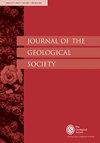Bidirectional subduction of the Proto-Tethys Ocean: Constraints from geochronology and geochemistry of S-type granites from Baoshan Block in western Yunnan (SW China)
IF 3
3区 地球科学
Q2 GEOSCIENCES, MULTIDISCIPLINARY
引用次数: 0
Abstract
Understanding the tectonic evolution of the Proto-Tethys Ocean is important for exploring the initial assembly of the Gondwana supercontinent. The closure of the Proto-Tethys Ocean represents the end of convergence along the northern edge of Eastern Gondwana. However, the timing and processes of the closing of the ocean have different interpretations. This work focuses on the early Paleozoic granitic rocks in the Baoshan Block (BSB), SW China, to constrain the tectonic evolution of the Proto-Tethys Ocean. Zircons from the Pinghe and Zhen'an granitic plutons yield concordant U–Pb ages from 489.8 Ma to 467.7 Ma. The bulk-rock geochemical features suggest that these samples are high-K, calc-alkaline, S-type granites enriched in LREEs and depleted in HREEs. With obvious negative Eu-anomalies and high K 2 O/Na 2 O ratios (1.01–2.57), they are enriched in LILEs and depleted in HFSEs. Thus, these rocks were derived from partial crustal melting associated with subduction of the converging plate. Previous studies on the Changning–Menglian suture zone suggested that the Early Paleozoic magmatic activity in the BSB was related to the westward subduction of the Proto-Tethys Ocean, combining the Early Paleozoic subduction-related magmatic activity to the east, it is suggested that the Changning–Menglian Ocean experienced bidirectional subduction.原特提斯洋的双向俯冲:滇西宝山地块s型花岗岩的年代学和地球化学约束
了解原特提斯洋的构造演化对探索冈瓦纳超大陆的初始组合具有重要意义。原特提斯洋的闭合代表了沿东冈瓦纳北部边缘汇聚的结束。然而,对海洋关闭的时间和过程有不同的解释。本文以中国西南宝山地块早古生代花岗岩为研究对象,对原特提斯洋的构造演化进行了研究。平河和镇安花岗质岩体锆石的U-Pb年龄在489.8 ~ 467.7 Ma之间。岩体地球化学特征表明,这些样品为高钾钙碱性s型花岗岩,富集轻稀土,贫稀土。它们具有明显的负eu异常和较高的k2o / na2o比值(1.01 ~ 2.57),在LILEs中富集,在hfse中贫化。因此,这些岩石来源于与汇聚板块俯冲有关的部分地壳熔融。前人对长宁-孟连缝合带的研究认为,BSB早古生代岩浆活动与原特提斯洋向西俯冲有关,结合其东部早古生代与俯冲有关的岩浆活动,认为长宁-孟连洋经历了双向俯冲。
本文章由计算机程序翻译,如有差异,请以英文原文为准。
求助全文
约1分钟内获得全文
求助全文
来源期刊

Journal of the Geological Society
地学-地球科学综合
CiteScore
6.00
自引率
3.70%
发文量
68
审稿时长
6-12 weeks
期刊介绍:
Journal of the Geological Society (JGS) is owned and published by the Geological Society of London.
JGS publishes topical, high-quality recent research across the full range of Earth Sciences. Papers are interdisciplinary in nature and emphasize the development of an understanding of fundamental geological processes. Broad interest articles that refer to regional studies, but which extend beyond their geographical context are also welcomed.
Each year JGS presents the ‘JGS Early Career Award'' for papers published in the journal, which rewards the writing of well-written, exciting papers from early career geologists.
The journal publishes research and invited review articles, discussion papers and thematic sets.
 求助内容:
求助内容: 应助结果提醒方式:
应助结果提醒方式:


